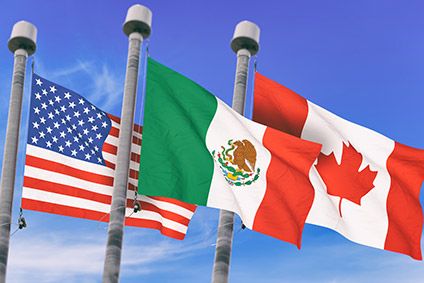
The North America Free Trade Agreement is to be replaced by a new deal after Canada, the United States and Mexico successfully concluded more than a year’s worth of talks – with the new pact called the United States-Mexico-Canada Agreement (USMCA).
A joint statement from United States Trade Representative Robert Lighthizer and Canadian Foreign Affairs Minister Chrystia Freeland announcing the move read: “USMCA will give our workers, farmers, ranchers and businesses a high-standard trade agreement that will result in freer markets, fairer trade and robust economic growth in our region. It will strengthen the middle class, and create good, well-paying jobs and new opportunities for the nearly half a billion people who call North America home.”
The plan to revamp the 24-year-old NAFTA kicked off in August 2017 with the US looking to rework the agreement in its favour, cut the trade deficit with Canada and Mexico, and pull more manufacturing jobs back to the US.
Several meetings then followed, with no deal reached. In early September this year, talks between Canada and the US over NAFTA became heated, with the US threatening to withdraw from the existing agreement and warning Congress not to interfere with negotiations.
Canada was adamant about getting the “right-deal”, meaning agreement could not be reached by 31 August, which President Donald Trump had hoped for. He then vowed to cut Canada out of any new deal between the US and Mexico.
Mexico had previously given the green light to a preliminary agreement with the US that could replace NAFTA. This included stronger textile provisions than the original trade pact, designed to incentivise greater US and Mexican production in textiles and apparel trade.
But with Canada and Mexico being the United States’ two biggest export markets, the US apparel industry risked being hurt if one of the partners were left out of a new deal.
Yesterday (30 September), the National Association of Manufacturers’ president and CEO Jay Timmons released a statement applauding the new USMCA, adding it creates more opportunities for US manufacturing workers, especially as the trade relationship with China has recently turned sour.
“There’s a massive amount of goods flowing across North America, meaning our countries’ economies are inextricably linked. What’s more, as the United States works to put an end to China’s cheating and unfair trade practices, we are better off united with our North American allies.
“As we review the agreement text, we will be looking to ensure that this deal opens markets, raises standards, provides enforcement and modernises trade rules so that manufacturers across the United States can grow our economy.”
American Apparel & Footwear Association (AAFA) president and CEO Rick Helfenbein also welcomed the announcement that a trilateral agreement would continue. “This shows that all three countries recognise the importance of the trilateral trading arrangement that has been fostered and supported by NAFTA during the past 24 years,” he said in a statement today (1 October).
“We look forward to reviewing the text in detail with our members and determining the impact it will have on the highly integrated North American apparel, footwear, and textile supply chain. We also remind the Administration of the need to seamlessly implement this new agreement so that companies are able to adjust to the new trading rules.”
Matthew Shay, president and CEO of the National Retail Federation (NRF), concurs. “We are pleased a deal has been reached that preserves NAFTA’s trilateral framework, which is critical to protecting North American supply chains that support millions of American jobs. The administration, as well as officials from Canada and Mexico, should be applauded for months of hard work aimed at modernising NAFTA for the 21st century – a goal retailers have shared from the start. We will carefully review all the details of the agreement to ensure it promotes US economic growth and maintains access to the products American families need at the prices they can afford.”
According to international trade law firm Sandler, Travis & Rosenberg (ST&R), the US-Mexico-Canada Agreement is expected to be signed by 1 December, which could bring it up for congressional consideration in early 2019.



